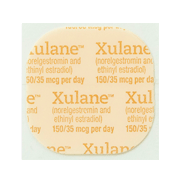The patch is simple to use: all you have to do is take off your old patch and put on a new one once a week, on the same day of the week, for three weeks in a row. On the day you would normally change your patch at the beginning of the fourth week, you’ll just take off the old one and not put on a new one.
For example, let’s say it’s Tuesday and you put on a new patch. Tuesday becomes your “patch change day.” In other words, your patches will always get changed (or just taken off, without putting a new one on) on Tuesdays.
You can put Zafemy and Xulane on your butt, stomach, the outer part of your upper arm, or your back, and Twirla can go on your butt, stomach, and your upper torso—never on your boobs, though. Just stick a single new patch on (and take the old one off) once a week for three weeks in a row, then go patchless (no patch) for the fourth week.
You’ll probably get a withdrawal bleed, which is like getting your period, during the patchless week, and you may still be bleeding when it’s time to put the patch back on. That’s totally normal. Put it on anyway.
_How to put on and take off the patch:_
1. If you start the patch within five days after starting your period, you’re protected from pregnancy right away. If you start later, you’ll have to wait seven days after putting on the patch before you’re protected, and during that time you’ll need to use a backup method of birth control, like condoms.
2. Think carefully about where you want to stick the patch—it’ll be there for a full week. Don’t put it where clothes are going to be rubbing up against it, like the waistband of your favorite jeans or your bra strap. And look for a spot where it won’t move around as much. So if you have a belly with folds, for example, that may not be the spot for you.
3. Once you’ve picked a spot, make sure the skin there is clean, dry, and not irritated.
4. Don’t use body lotion, oil, powder, creamy soaps (like Dove or Caress) or makeup on the spot where you’ll put your patch.
5. Only peel off half of the clear plastic at first, so you’ll have a non-sticky side to hold on to.
6. Don’t touch the sticky part of the patch with your fingers. It’s very, very sticky and will be hard to get off your fingers.
7. Press the patch down for a full 10 seconds to get a good, firm stick.
8. Check your patch every day to make sure it’s sticking right. The hormones are in the sticky stuff, so it’s super important that it’s completely stuck to your skin with no peeling at the edges and no wrinkles. Take it off and put on a brand new patch if you ever find that your patch is not fully stuck to your skin.
9. If there’s a bit of lint build-up around the area where your patch was when you take it off, you can use baby oil to get it and any remaining adhesive off your skin.
10. When you take a patch off, fold it in half before you throw it in the trash and never flush it down the toilet. That’ll help keep hormones out of the environment.
11. Don’t put your new patch on in the same spot where your last patch was.


